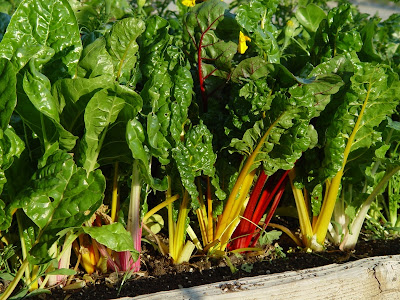Swiss chard is having an identity crisis. Not as popular as carrots or as tasty as tomatoes, this prolific relative of spinach is in need of a good publicist. Being a biennial it will take two years to complete its lifecycle and go to seed. To the school gardener and the home gardener this means greater reward for your labor. With minimal effort one can be picking Swiss chard 52 weeks a year in our mild winter climate. Just pick the outer leaves and leave the smaller inner ones intact.
 This lovely rainbow variety does cause heads to turn and students clamor to take a few cuttings home simply because “it looks pretty”, however, the one question I get from everyone, including teachers is, what do you do with it? My simple answer is, its in the same family as spinach, any recipe calling for cooked spinach can be substituted with the green leaves of Swiss chard, the stems are another story and we’ll get to that in a second. Below you will find two recipes for Swiss chard, the first is for the leaves, the second, for the stems.
This lovely rainbow variety does cause heads to turn and students clamor to take a few cuttings home simply because “it looks pretty”, however, the one question I get from everyone, including teachers is, what do you do with it? My simple answer is, its in the same family as spinach, any recipe calling for cooked spinach can be substituted with the green leaves of Swiss chard, the stems are another story and we’ll get to that in a second. Below you will find two recipes for Swiss chard, the first is for the leaves, the second, for the stems.
Pasta with Swiss Chard and Sausage
In boiling salted water cook ½ lb pasta for 10 minutes, drain in colander. In same pot sauté ½ cup onion and 2 cloves garlic in 2 TB olive oil. Add one chopped turkey sausage and cook till browned. Add two bunches chopped Swiss Chard (about 3-4 cups) and sauté till wilted, adding up to ½ cup of broth (chicken or vegetable) as needed, about 10-15 minutes. Add cooked pasta, salt and pepper to taste and sprinkle with Parmesan cheese before serving.
Swiss Chard Stems Moroccan Style
Chop stems from two bunches of Swiss chard (approximately 2-3 cups) and sauté with one onion and two cloves of garlic in 2 TB olive oil. Add a little chicken broth, vegetable broth or water, about ¼ cup, and cook till softened, about 10-15 minutes. Pour off liquid then stir in 3-4 tablespoons of tahini (start with 3 then add more as needed), juice of one lemon, two tablespoons olive oil, pinch of garlic salt, pinch of cumin, salt and pepper to taste.
Enjoy!
